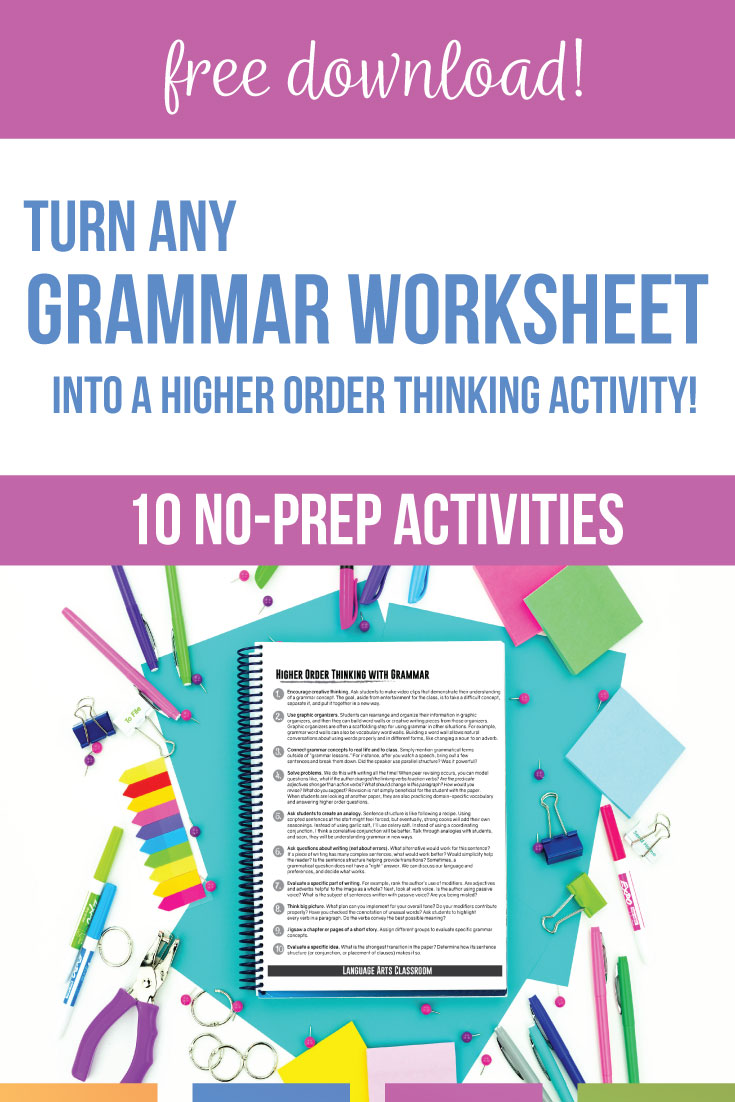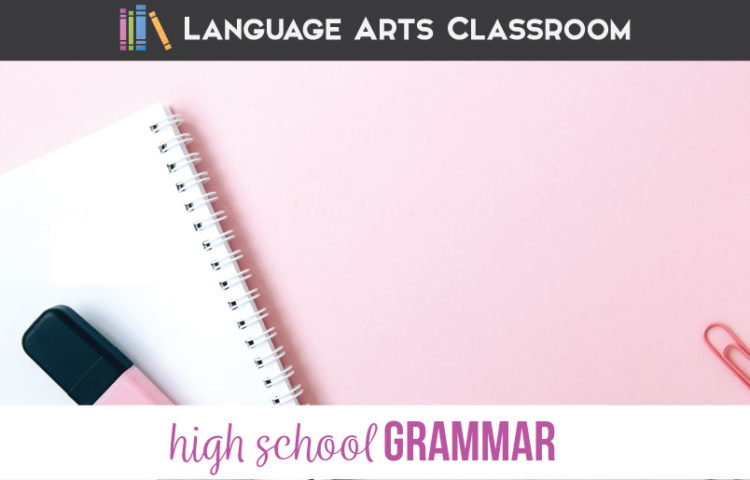Grammar for high school theoretically should activate higher level thinking processes. Standards for high school students are difficult, but with a strong presentation, students will see the power in understanding language.
Language standards for older students might seem overwhelming, and I have absolutely struggled some years to reach all students. Why? The standards for higher grades require more than identification: Students should apply the concepts to their writing and analyze the grammatical components in literature and nonfiction. Students should manipulate the language and play with the rules in their writing and speaking.
Grammar for high school should look like that.
Still, I know that often, grammar lessons for high school might start with a review or introduction to the eight parts of speech. Sometimes, teachers only present grammar as “what is wrong with your writing.” No wonder students dislike grammar lessons.
We’re not going to create grammar lessons that bore students. Grammar lessons to help high school students should encourage writers, employ mentor sentences, & work with students, not against them.

We high school teachers don’t always get students who are ready for these higher processes concerning grammar. (Note: I am not blaming anyone, especially other teachers. I taught junior high students for a year, and teaching them grammar was, trying. The focus of this article is not to blame, but to address a common situation with which high school teachers deal.) I’ve broken this blog post into two parts: students who come to high school with little grammar knowledge, and high school students who come to high school with grammar knowledge.
My students know very little grammar.
Sometimes, you will teach high school students who cannot use domain-specific vocabulary well. For instance, if you realize that when you deal with comma splices that students cannot identify subjects and verbs, you might need to review basic subjects and verb. Then you can advance to sentence structure. If you cannot start with the standards immediately, start with a few basic concepts.
Here are more ideas for grammar for high school English classes when students are largely unfamiliar with grammatical terms.
Introduce basic concepts.
The eight parts of speech, parts of a sentence, verbals, punctuation: many high school students cannot identify or do not understand these terms. With a brief overview, high school students can find success, especially when they practice writing those ideas after learning about them.
The Common Core Standards have students learning basic grammar concepts in grades K-8, and then using, applying, and demonstrating those concepts in reading, writing and speaking in 9-12.
By no means are the standards perfect, but the idea makes sense: Students will understand the language when they are younger and be able to manipulate and apply ideas when they are older.
Education may lean toward the right idea, but how should grammar for high school look today? Teachers can’t say, “well, they’re supposed to understand this!” and mosey along to the next standard. At times, we high school English teachers must teach grammar basics, and move students along toward the evaluation and synthesis of grammar in other parts of the curriculum.
So, after introductions to concepts, what should I do?
Move forward.
One way to handle this is to provide students with older-looking materials. The subject matter may be typically taught in lower grades, but the materials should look age-appropriate. The material must be tied to other parts of class and hopefully students’ lives. I don’t give assignments across the board. I learn students’ strengths and areas for improvement, and then give targeted practice. Not every student needs to review nouns, and not every student needs to review conjunctions. I cannot encourage differentiation enough with grammar lessons to help high school students: Use different tools to reach different levels.
A second way to handle grammar in high school is with the teacher’s attitude. Inevitably, students will ask about the content, knowing that they have studied these concepts before. What if we explained the reasons for reviewing? Give students our reasoning; provide them with the goal of learning these basics. A rational approach to reviewing younger material can help. You might even clue parents and guardians into your efforts with a grammar newsletter.
Finally, explaining to students how the concepts build on each other in language study help with grammar in high school. Consider that to punctuate and use a variety of sentences, students must know an assortment of concepts. They must recognize subject and verb, identify different types of conjunctions, understand punctuation rules, and know the differences between phrases and clauses. Grammar requires a foundation before the curtains and wallpaper are hung.
Grammar for high school often includes the teaching of concepts, and the analysis of these concepts. It’s difficult because students are reluctant; either they find the material disconnected from their lives, or they feel that they should have learned it years ago. They may remember that it was taught years ago, and feel frustration that they haven’t grasped it. Whatever the reason, accommodating and being cognizant of the situation may help our students.
My students understand grammar.
If your students grasp some grammatical concepts, you might need a different approach. Start with standards. You’ll have less review, but more application, analysis, and synthesis with concepts.
Find concepts naturally.
Practice sentences can work well to teach students grammatical standards but eventually, you’ll want students to find examples and ideas naturally. As you read literature and informational texts, mark difficult concepts and unusual sentences. Be sure to challenge students by applying grammatical concepts to other areas.
Next, specifically use the high school grammar concepts in writing. For instance, the standards for high school deal with specifics such as adjective clauses and adverb clauses. After you teach those concepts and practice them, ask students to implement them in their writing. No matter what you are reading, ask students to write a response to the literature or nonfiction and to use a noun clause. Ask students to implement parallelism in a compound sentence. Take whatever concept you are studying, and ask students to show you their knowledge of it. (You can download a free sheet for critical thinking with grammar. Sign up at the end of this post.)
The process might seem forced at first, but after a few times of applying these concepts to writing, students will consider their knowledge a benefit. They will be glad they possess ways to manipulate their writing. Then, ask students to find a concept (a type of phrase or clause) in their writing. They probably have them! Praise students with their correct use because grammar lessons should be empowering and positive.
Consider the future.
I’ve frequently see memes and jokes with the message that teachers should care more about what type of person a student becomes than if the student knows. . . (fill in the blank with an abstract concept). I care about both. One way that I teach hard work and dedication is by working through difficult concepts with students. I show students that they can achieve and understand complex concepts by helping them to understand hard concepts!
Grammar and language can create tough lessons, but future linguists, attorneys, and teachers should own a knowledge of grammar. They should not have to play catch-up in college.
Finally, grammar for high school often involves test prep—and I know that is unsavory. Most teachers dislike standardized testing (this teacher included), but the test prep can be fun. Older students enjoy coloring, stations, and jigsawing practice. Address common grammar errors that students will face on those tests, and remember to return to discussing grammar and language as part of class. When students are comfortable talking about grammar, they are less frightened of standardized tests.
Plus, you are preparing them for their future. Everyone should communicate effectively with a pocketful of tools.
No matter how your students arrive in your classroom, you can teach grammar in meaningful ways. Grammar lessons to help high school students require assessing the students’ knowledge and moving from there.






